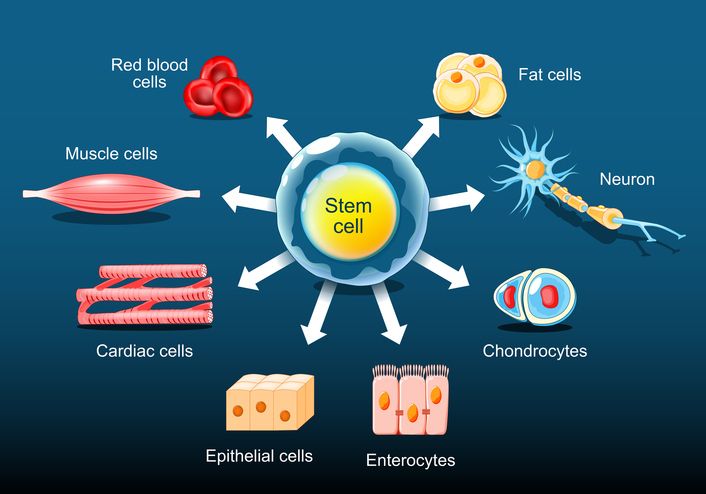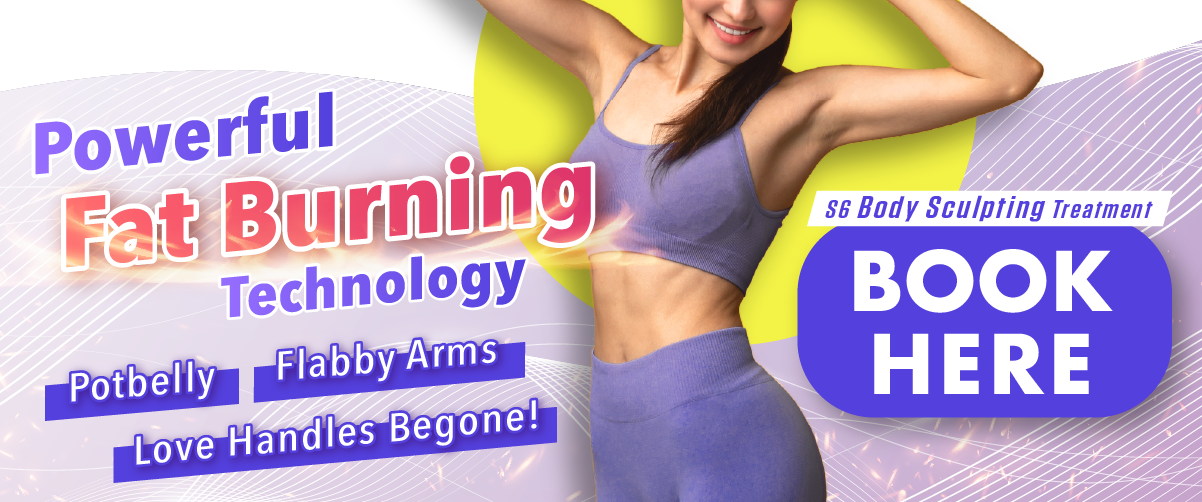
Author: Natalie Ng|Updated: 9 May 2025
There isn’t just one kind of cellulite — there are ten. Some types are soft, others are hard or edematous. Some show up from fluid retention or excess fat, while others are linked to hormones, poor blood flow, or changes in skin structure. That’s why treating cellulite isn’t one-size-fits-all. Cellulite forms when fat cells push into the connective tissue beneath the skin, causing dimples or an orange peel texture. It’s more common in women, thanks to differences in fat distribution and skin elasticity, but it can affect anyone. Things like weight gain, fluid retention, and even muscle loss can all make it more noticeable. Each type of cellulite needs a different approach — from a healthy diet and lifestyle changes to treatments that help with collagen production, skin tightening, or breaking down fibrous tissue. Keep reading to find out which type you might have and how to treat it.

How Does Cellulite Form?
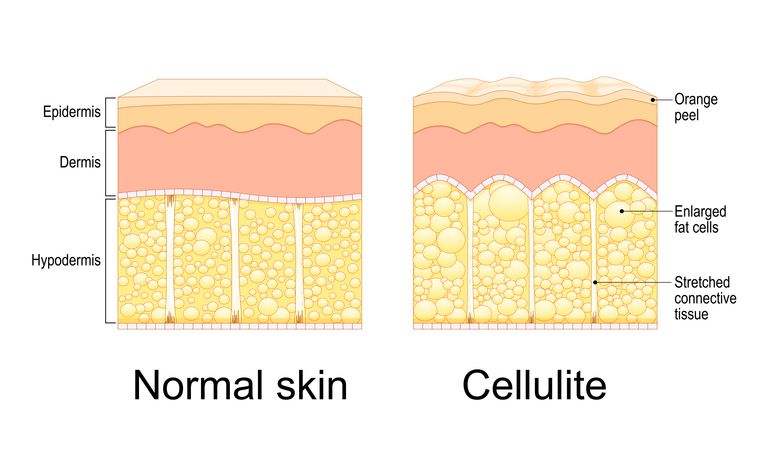
Cellulite forms when fat cells in the superficial layer of the skin push up against weak or stretched connective tissue. This creates an uneven surface and leads to the familiar dimpled skin or orange peel effect. It’s a harmless skin condition, but one that affects appearance — especially in areas like the thighs, hips, buttocks, and abdomen.
Fat Distribution and Skin Structure
Cellulite mostly develops in areas where subcutaneous fat is stored. Female skin tends to show it more clearly due to differences in fat distribution and the vertical alignment of connective tissue. Male skin is thicker and has tighter fibrous bands, which makes cellulite less visible but not impossible.
Changes in the structure of collagen and fibrous connective tissue also affect how cellulite appears. As collagen breaks down — due to aging, weight gain, or lack of activity — the skin becomes thinner and less elastic. This makes the fatty tissue underneath more noticeable.
Role of Blood Flow and Fluid Retention
Poor blood circulation can weaken skin and reduce the supply of oxygen and nutrients. This slows down collagen production and skin repair. At the same time, blocked lymphatic drainage leads to fluid retention, which adds pressure in the tissue and worsens swelling.
When blood flow slows down and toxins build up in adipose tissue, the skin texture changes. Over time, cellulite becomes more visible and harder to manage without targeted treatment.
Now that we've covered how cellulite forms and the factors that influence its appearance, let's take a closer look at the different types. Each type has its own characteristics and may respond differently to various treatments.

Type 1: Soft Cellulite — The Most Common Type
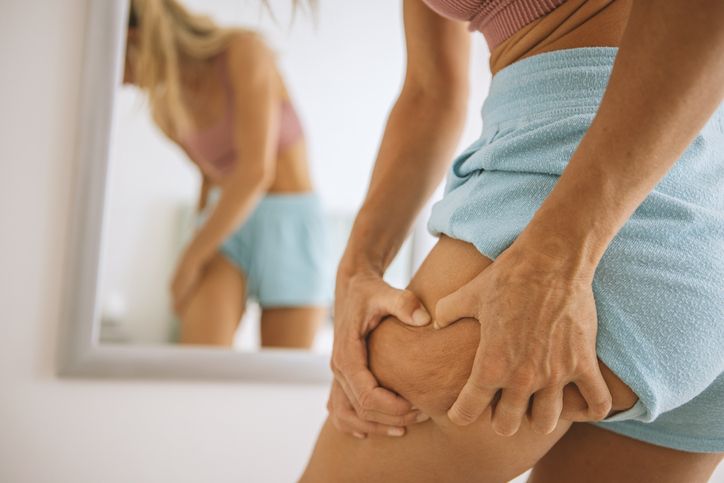
What It Looks Like
Soft cellulite feels loose and looks like jelly under the skin. It’s usually more visible when standing, especially on the thighs, hips, and buttocks. It tends to move when you touch it. This type shows up more often in people with poor muscle tone or those who’ve had weight gain or weight loss over time.
Why It Happens
Soft cellulite forms when fat cells push through weak connective tissue. This can be made worse by skin laxity, poor blood circulation, or low muscle mass. A sedentary lifestyle and excess fat in the superficial layer also make it easier for cellulite to appear. It’s more common in female skin because of how subcutaneous fat and connective tissue are arranged.
How to Treat It
The best way to treat soft cellulite is to build muscle and improve skin elasticity. Strength training helps tighten the skin and reduce fat under the surface. Focus on glutes, legs, and core. Add cardio to improve blood flow and help with fat reduction. A healthy diet matters too — avoid processed foods and eat more lean protein, vegetables, and fiber to support skin structure and reduce fluid retention.
Hydration helps with lymphatic drainage and reduces the appearance of cellulite. Over time, this routine can improve skin texture, stimulate collagen production, and support long-term cellulite reduction.
Read More
Book Now to Experience
S6 Body Sculpting Treatment
1 Minute Self-Registration
Date should not be before minimal date

Type 2: Hard Cellulite — Firm and Deep-Set

What It Looks Like
Hard cellulite feels dense and tightly packed. It doesn’t move when pressed and usually stays visible whether you’re standing or lying down. You’ll often see it on the outer thighs and lower buttocks, where the skin takes on a firm, orange peel texture.
Why It Happens
This type of cellulite sticks closely to the deeper layers of tissue. It’s linked to increased muscle tone, tension in the skin, and a buildup of fibrous connective tissue. While soft cellulite may shift under the surface, hard cellulite stays fixed in place. It’s common in younger women and people who have more muscle mass, including athletes. The skin in these areas often feels cold or looks pale because of poor blood circulation.
The dimpling forms when fat cells push through stiff connective tissue and the surrounding skin can’t stretch or move easily. The structure underneath becomes tight, pulling the skin down and creating visible indentations. These dense bands of tissue make it harder for lymphatic drainage and blood flow to work properly.
How to Treat It
Hard cellulite doesn’t respond well to basic massage or gentle treatments. Because the tissue is more rigid, you'll need treatments that reach deeper layers of the skin. Acoustic wave therapy, radiofrequency, and targeted manual lymphatic drainage can help improve circulation, soften the tissue, and reduce the appearance of cellulite.
Keeping the skin hydrated and supporting collagen production through a healthy diet can also help over time. Treatments that focus on improving skin texture and blood flow are key to softening the tight structure and improving elasticity.

Type 3: Diet-Induced Cellulite — Driven by Poor Nutrition
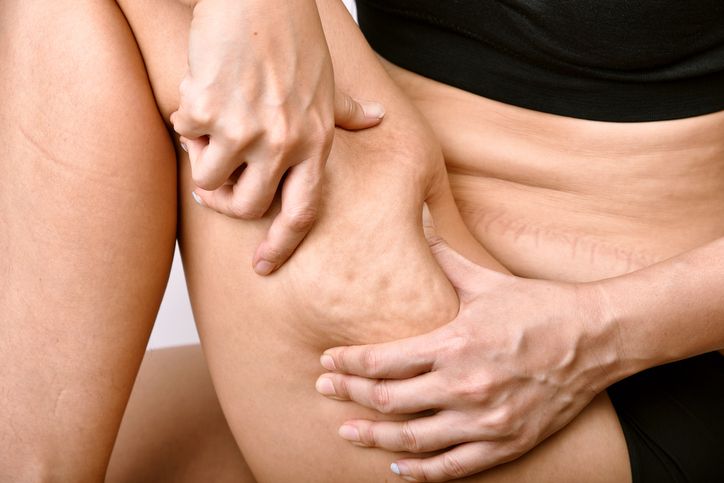
What It Looks Like
Diet-induced cellulite often looks soft or swollen, with visible dimples across areas like the thighs, hips, and abdomen. The skin may appear uneven and lack tone.
Why It Happens
A diet high in processed foods, refined sugar, and unhealthy fats can contribute to cellulite by increasing fat cells and weakening connective tissue. These foods promote fluid retention, inflammation, and poor blood circulation — all of which affect how cellulite forms and spreads.
Too much sodium causes water retention, while excess sugar breaks down collagen and impacts skin elasticity. Trans fats and low nutrient intake disrupt fat metabolism, making it easier for fat to build up under the skin.
How to Treat It
The most effective approach is to adjust your diet. Replace processed foods with whole foods rich in antioxidants, lean protein, and healthy fats. Eat more vegetables, fruits, and omega-3s to support collagen production and reduce inflammation.
Hydration is also essential. Drinking enough water helps flush out excess sodium and supports lymphatic drainage. Over time, a nutrient-dense, balanced diet will improve skin structure and help reduce the appearance of cellulite.
Book Now to Experience
S6 Body Sculpting Treatment
1 Minute Self-Registration
Date should not be before minimal date

Type 4: Genetic Cellulite — Inherited from Family

What It Looks Like
Genetic cellulite varies in texture and severity, but often shows up in the same areas as in your relatives. It may appear early in life, sometimes even before adulthood, and tends to follow familiar patterns.
Why It Happens
Your genes play a role in how fat cells are distributed, how strong your connective tissue is, and how your body handles hormones. If cellulite appears in your family, you’re more likely to develop it too.
Genetic cellulite isn’t caused by poor habits, but it can be worsened by them. The way your body stores subcutaneous fat or responds to changes in blood flow and hormone levels is mostly inherited.
How to Treat It
You can’t change your genes, but you can reduce cellulite by supporting your skin and tissues through healthy habits. Consistent exercise, a balanced diet, and treatments like acoustic wave therapy or manual lymphatic drainage can all help.
For genetically influenced cellulite, maintenance is key. A steady approach to skin tightening and fat reduction will help manage its appearance long term.

Type 5: Muscular Cellulite — Seen on Toned Bodies
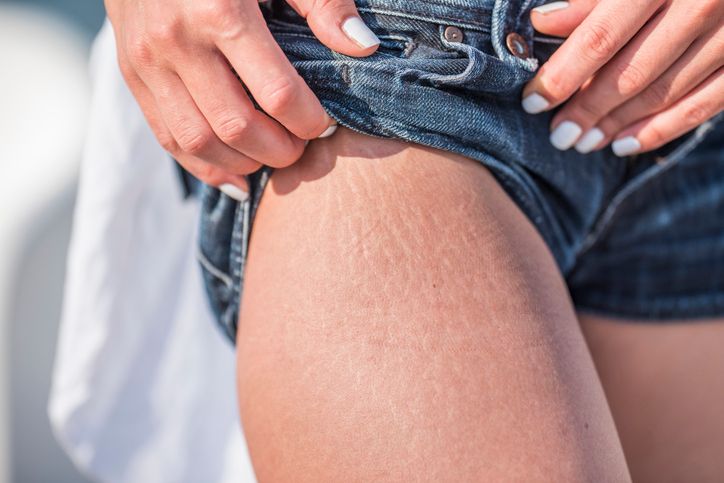
What It Looks Like
Muscular cellulite shows up as dimples or skin irregularities on otherwise firm, toned areas — especially the thighs or buttocks. The skin can look uneven, even with low body fat.
Why It Happens
Even with more muscle mass, cellulite occurs when superficial fat pushes into the connective tissue above the muscle. In athletic bodies, the skin may sit tighter against underlying muscle, making any irregularity more noticeable.
Hormones, skin thickness, and fat distribution still play a bigger role than muscle alone. A sedentary lifestyle isn’t required for cellulite to form — it can appear on active bodies too.
How to Treat It
Improving skin elasticity and smoothing the outer layer is the goal. Treatments that stimulate collagen production and increase circulation — such as radiofrequency or skin-tightening devices — can help reduce dimpled skin.
Staying hydrated and maintaining a balanced diet will also support the connective tissue beneath the skin and keep it resilient over time.
Book Now to Experience
S6 Body Sculpting Treatment
1 Minute Self-Registration
Date should not be before minimal date

Type 6: Mixed-Type Cellulite — Most Common in Adults

What It Looks Like
Mixed-type cellulite is a combination of two or more cellulite types, such as soft, fibrous, or edematous. It causes dimpling, swelling, and uneven skin texture in different areas of the body.
Why It Happens
This form develops when several contributing factors overlap — like hormonal changes, poor diet, fluid retention, and lack of muscle tone. It’s common in adults who’ve experienced body changes over time, such as weight gain, pregnancy, or aging.
Different body parts may show different types of cellulite at the same time, which makes it harder to treat with a single method.
How to Treat It
Because multiple issues are involved, treatment needs to be multi-step. You’ll likely need to combine skin tightening, lymphatic drainage, and collagen-boosting therapies. Regular exercise and a nutrient-rich diet support circulation and reduce fat cell expansion.
A professional assessment can help target the most affected areas and guide you toward the most effective treatment options for your mix of cellulite types.

S6 Body Sculpting Treatment: Supporting Cellulite Reduction Across All Types
Cellulite can form in many ways — from soft, loose textures to firmer, deeper dimpling caused by fibrous connective tissue. While a healthy diet and regular exercise help, they don’t always address cellulite effectively, especially in stubborn areas like the thighs, lower buttocks, or abdomen. The S6 Body Sculpting Treatment provides a non-invasive solution that targets the causes of cellulite across different skin types and fat layers.
How S6 Body Sculpting Works
S6 Body Sculpting uses low-energy bio-laser technology to break down fat cells in the subcutaneous tissue. This process releases fatty acids, which are then processed through the lymphatic system. Vacuum suction is applied at the same time to improve lymphatic drainage and increase blood flow. Together, these actions help reduce subcutaneous fat, support collagen production, and smooth the skin surface.
By improving skin structure and circulation, the treatment helps reduce the appearance of cellulite caused by fluid retention, poor blood flow, and weak connective tissue — common issues in both soft and edematous cellulite. It also addresses deep-set dimples seen in fibrous cellulite by loosening fat deposits and stimulating the tissue below the skin.
Advantages of S6 Body Sculpting
• Non-Invasive and Comfortable: No surgery, injections, or medication required. Treatment is safe and comfortable for most skin types.
• Targets Multiple Body Areas: Focuses on seven key zones prone to cellulite — arms, belly, waist, buttocks, thighs, calves, and back.
• Reduces Fat Cells: Supports fat reduction by breaking down fatty tissue and speeding up metabolism.
• Boosts Skin Firmness: Stimulates collagen to improve skin elasticity and reduce skin laxity after fat loss.
• No Downtime: You can return to work or regular activities immediately after treatment.
Supporting Long-Term Cellulite Improvement
S6 Body Sculpting is most effective when combined with healthy lifestyle habits. Drinking water regularly, eating a balanced diet, and staying active all support the treatment process. By targeting both the fat layer and the skin’s connective tissue, this treatment enhances the overall appearance of dimpled skin and improves the skin’s tone and texture.
Interested in smoother skin and more defined body contours? Book your S6 Body Sculpting Treatment today and take the next step toward reducing cellulite safely and effectively.
New Beauty's S6 Body Sculpting TreatmentBook Now to Experience
S6 Body Sculpting Treatment
1 Minute Self-Registration
Date should not be before minimal date
FAQ
1. Can cellulite appear on lean or athletic bodies?
Yes, cellulite can develop on individuals with low body fat or high muscle mass. It's not solely related to excess fat but also involves the structure of connective tissue and fat cells beneath the skin. Factors like genetics, hormonal fluctuations, and skin elasticity play significant roles in the formation of cellulite, regardless of overall body composition.
2. How does hormonal imbalance affect the development of cellulite?
Hormonal changes, particularly involving estrogen, insulin, and thyroid hormones, can influence fat distribution and connective tissue integrity. These hormonal fluctuations may lead to increased fat deposition and reduced skin elasticity, contributing to the appearance of cellulite. Periods of hormonal change, such as puberty, pregnancy, and menopause, often coincide with the onset or worsening of cellulite.
3. Are there specific dietary habits that can exacerbate cellulite?
Diets high in processed foods, refined sugars, and excess sodium can contribute to the development and visibility of cellulite. Such dietary choices may lead to fluid retention, inflammation, and fat accumulation, all of which can affect skin texture and connective tissue health. Conversely, a balanced diet rich in antioxidants, lean proteins, and healthy fats supports skin elasticity and overall tissue health, potentially reducing the appearance of cellulite.
4. Does poor blood circulation influence the severity of cellulite?
Yes, inadequate blood flow can impair the delivery of nutrients and oxygen to skin and connective tissues, weakening their structure and resilience. This can lead to the accumulation of subcutaneous fat and the formation of dimpled skin characteristic of cellulite. Improving circulation through regular physical activity and certain therapies may help mitigate these effects.
5. Can lifestyle changes alone effectively reduce cellulite, or are treatments necessary?
While adopting a healthy lifestyle—including regular exercise, a nutritious diet, and proper hydration—can improve skin tone and reduce the visibility of cellulite, these measures may not eliminate it entirely. For more pronounced cases, treatments like S6 Body Sculpting can complement lifestyle changes by targeting fat cells, enhancing lymphatic drainage, and stimulating collagen production, leading to improved skin texture and reduced cellulite appearance.
Recommended Articles
COPYRIGHT© NEW BEAUTY MANAGEMENT LIMITED 2025. ALL RIGHT RESERVED.



